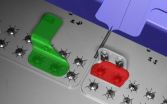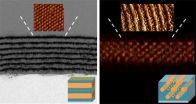(Press-News.org) Today's cars are increasingly custom-built. One customer might want electric windows, heated door mirrors and steering-wheel-mounted stereo controls, while another is satisfied with the minimum basic equipment. The situation with aircraft is no different: each airline is looking for different interior finishes – and lighting, ventilation, seating and monitors are different from one company to the next. Yet the customer's freedom is the manufacturer's challenge: because individual parts and mountings have to be installed in different locations along the fuselage, automated assembly is often not an economical alternative. For many assembly steps, manufacturers have to rely on manual labor instead. But if errors creep in – if, for instance, a bracket is mounted backwards or in the wrong place – correcting them can get expensive later on. The fuselage has to be reworked at great expense. Today, employees use design drawings to determine whether the individual parts have been attached properly, or else manufacturers use rigid and inflexible testing systems to check the part against comparison photos. This calls for an identical part for the template photo – and that can be difficult where one-off parts are concerned.
Now, researchers at the Fraunhofer Institute for Factory Operation and Automation IFF in Magdeburg have come up with a testing technology that is reliable and economic even for one-off production runs. "The automated visual testing system generates a digital template and uses it to compare with the assembled components. It reliably identifies any errors," points out Steffen Sauer, project manager for measuring and testing technology at IFF. First, an automated camera system takes hundreds of photos of individually assembled holders, load-bearing elements and parts on the inside of the fuselage shell. For every picture taken, the system determines the exact position of the camera relative to the fuselage shell. At the same time, the software generates the same shots again – but this time using a "virtual" camera. So essentially it creates "photos" using the data of the digital design model. The system compares the photos of real parts with the "virtual" images. If the system detects any deviations – if, say, a bracket is backwards – it issues a warning. Parts that have not been installed properly are highlighted on the monitor screen. The interesting thing is these steps are completely automatic.
In addition to a two-dimensional check using the photos, the system can also check a completed aircraft fuselage in three dimension: as in the case of the photos, it uses design data to generate three-dimensional data that it then compares with measurements on the real assembly. Here, conventional 3D measurement methods are used to digitalize the components. "What's new about this system is that we convert specifications from the design models into images and 3-D data that the system can then compare with the real images," explains Sauer.. The system also automatically draws up the testing plan: first, it identifies the best measuring position for every part to be tested. What is the best location from which to test the component in question? The system forwards the results to the robot, which in turn travels to the position identified, where it shoots the two or three-dimensional images. There is another advantage to this approach: this way, the system can react quickly and flexibly. The result is a continuous process, from design to the finished and assembled part.
The main challenge to researchers was to set up the virtual camera that uses design models to "photograph" the as yet non-existent component. Another crunch point was to quickly and automatically locate the interesting areas from among the many millions of points in the three-dimensional images – to hunt down, in the mass of points, the tiny components such as brackets and holders, and to check to see whether they are properly fitted. The fields of application for this testing technology are diverse: the technology can be used wherever flexibility is required and individual parts frequently change. The only condition: design data must be available. Researchers will be presenting the new technology at the Control trade fair, May 8-11 in Stuttgart (Hall 1, stand 1502). The process will be ready to use by summer 2012.
INFORMATION:
Assembly errors quickly identified
2012-04-30
ELSE PRESS RELEASES FROM THIS DATE:
Golden potential for gold thin films
2012-04-30
Scientists with the Lawrence Berkeley National Laboratory (Berkeley Lab) and the University of California (UC) Berkeley have directed the first self-assembly of nanoparticles into device-ready materials. Through a relatively easy and inexpensive technique based on blending nanoparticles with block co-polymer supramolecules, the researchers produced multiple-layers of thin films from highly ordered one-, two- and three-dimensional arrays of gold nanoparticles. Thin films such as these have potential applications for a wide range of fields, including computer memory storage, ...
New graphene-based material could revolutionize electronics industry
2012-04-30
The most transparent, lightweight and flexible material ever for conducting electricity has been invented by a team from the University of Exeter. Called GraphExeter, the material could revolutionise the creation of wearable electronic devices, such as clothing containing computers, phones and MP3 players.
GraphExeter could also be used for the creation of 'smart' mirrors or windows, with computerised interactive features. Since this material is also transparent over a wide light spectrum, it could enhance by more than 30% the efficiency of solar panels.
Adapted from ...
lobSTR algorithm rolls DNA fingerprinting into 21st century
2012-04-30
CAMBRIDGE, Mass. (April 27, 2012) – As any crime show buff can tell you, DNA evidence identifies a victim's remains, fingers the guilty, and sets the innocent free. But in reality, the processing of forensic DNA evidence takes much longer than a 60-minute primetime slot.
To create a victim or perpetrator's DNA profile, the U.S. Federal Bureau of Investigation (FBI) scans a DNA sample for at least 13 short tandem repeats (STRs). STRs are collections of repeated two to six nucleotide-long sequences, such as CTGCTGCTG, which are scattered around the genome. Because the ...
New avocado rootstocks are high-performing and disease-tolerant
2012-04-30
RIVERSIDE, Calif. — Avocado, a significant fruit crop grown in many tropical and subtropical parts of the world, is threatened by Phytophthora root rot (PRR), a disease that has already eliminated commercial avocado production in many areas in Latin America and crippled production in Australia and South Africa. Just in California the disease is estimated to cost avocado growers approximately $30-40 million a year in production losses.
Research on developing PRR-tolerant rootstocks to manage the disease has been a major focus of avocado research at the University of California, ...
Big girls don't cry
2012-04-30
A study to be published in the June 2012 issue of Journal of Adolescent Health looking at the relationships between body satisfaction and healthy psychological functioning in overweight adolescents has found that young women who are happy with the size and shape of their bodies report higher levels of self-esteem. They may also be protected against the negative behavioral and psychological factors sometimes associated with being overweight.
A group of 103 overweight adolescents were surveyed between 2004 and 2006, assessing body satisfaction, weight-control behavior, ...
Notre Dame paper examines nanotechnology-related safety and ethics problem
2012-04-30
A recent paper by Kathleen Eggleson, a research scientist in the Center for Nano Science and Technology (NDnano) at the University of Notre Dame, provides an example of a nanotechnology-related safety and ethics problem that is unfolding right now.
The world of nanotechnology, which involves science and engineering down at billionths-of-a-meter scales, might seem remote.
But like most new advances, the application of that technology to everyday experience has implications that can affect people in real ways.
If not anticipated, discussed or planned for, some of those ...
NASA's Landsat satellites see Texas crop circles
2012-04-30
VIDEO:
In this time series animation, vegetation appears red and the bare soil of fallow fields or sparsely vegetated grasslands appear white to green. The blue-gray X near the center of...
Click here for more information.
A water-rich polka dot pattern takes over the traditional rectangular patchwork of fields in this time series animation of 40 years of Landsat images. In the dry Texas panhandle near the town of Dalhart, this transformation is due to center-pivot irrigation, ...
Moffitt researchers find adolescents with cancer concerned about their future reproductive health
2012-04-30
Researchers at Moffitt Cancer Center and colleagues have found that adolescents newly diagnosed with cancer have strong concerns about their ability to have children as cancer survivors. They also found that standard health-related quality-of-life survey tools used to elicit answers from teens with cancer did not accurately reflect these concerns. Parents, who often answer survey questions as proxies, often inaccurately relayed their child's reproductive concerns.
The study, carried out by Moffitt researchers and colleagues from the University of South Florida, the University ...
Moffitt Cancer Center researchers working at frontiers of melanoma research
2012-04-30
At Moffitt Cancer Center, patients with stage III and IV unresectable melanoma are now routinely genetically profiled for several gene mutations, including the BRAF gene, a known driver oncogene for melanoma. Research has shown that mutations in the BRAF gene determine sensitivity or resistance to a class of drugs that are BRAF inhibitors.
"We have found that a large number of patients with melanoma who have the BRAF gene mutation quickly develop resistance to drugs that are BRAF inhibitors," said Jeffrey S. Weber, M.D., Ph.D., director of the Donald A. Adam Comprehensive ...
Moffitt Cancer Center researchers: Quality of life as important as quantity of life
2012-04-30
Researchers at Moffitt Cancer Center have placed new emphasis on gathering data on cancer patient quality of life during both treatment and survivorship. Their focus is on gathering and using that data to develop interventions to improve the quality of life for patients in treatment and for cancer survivors.
Much of the quality of life and survivorship research is carried out by researchers in Moffitt's Department of Health Outcomes & Behavior.
"Among the several research goals of the Department of Health Outcomes & Behaviors is the evaluation and improvement of quality ...



